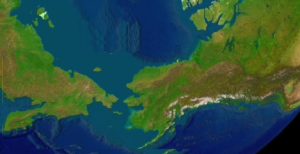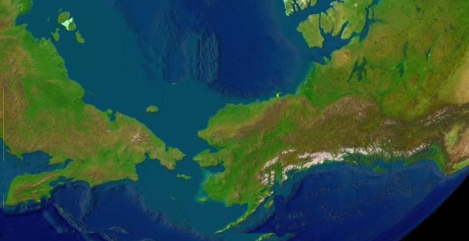
UNIVERSITY OF VIRGINIA—University of Virginia linguistic anthropologist Mark A. Sicoli and colleagues are applying the latest technology to an ancient mystery: how and when early humans inhabited the New World. Their new research analyzing more than 100 linguistic features suggest more complex patterns of contact and migration among the early peoples who first settled the Americas.
The diversity of languages in the Americas is like no other continent of the world, with eight times more “isolates” than any other continent. Isolates are “languages that have no demonstrable connection to any other language with which it can be classified into a family,” Sicoli said. There are 26 isolates in North America and 55 in South America, mostly strung across the western edge of the continents, compared to just one in Europe, eight in Africa[?] and nine in Asia.
“Scientists in the past few decades have rethought the settlement of the Americas,” Sicoli said, “replacing the idea that the land which connected Asia and North America during the last ice age was merely a ‘bridge’ with the hypothesis that during the last ice age humans lived in this refuge known as ‘Beringia’ for up to 15,000 years and then seeded migrations not only into North America, but also back into Asia.”
In a Feb. 17 presentation to the annual meeting of the American Association for the Advancement of Science in Boston, Sicoli will join other scientists discussing “Beringia and the Dispersal of Modern Humans to the Americas.” Since much of Beringia, theorized to have been located generally between northwest North America and northeastern Asia, has been under water for more than 10,000 years, it has been challenging to find archaeological and ecological evidence for this “deep history,” as Sicoli calls it.
Recent ecological, genetic and archaeological data support the notion of human habitation in Beringia during the latest ice age. The new linguistic research methods, which use “big data” to compare similarities and differences between languages, suggest that such a population would have been linguistically diverse, Sicoli said.
In “Linguistic Perspectives on Early Population Migrations and Language Contact in the Americas,” Sicoli shows how big data analyses point to the existence of at least three now-extinct languages of earlier migrations that influenced existing Dene and Aleut languages as they moved to the Alaska coast. The data comparing dozens of indigenous languages support phases of migration for the Dene languages and multilingual language contact systems along the Alaska coast, which potentially involved languages related to current linguistic isolates. Traces of such language contacts support that the mixing populations also mixed their languages as part of human adaptation strategies for this region and its precarious environment.
“The computational methods give us traction on questions that have been unanswered,” said Sicoli, who has been working in collaboration with Anna Berge of the University of Alaska and Gary Holton of the University of Hawaii. “They help us understand how people migrated and languages diversified not simply through isolation, but through multilingual contact.”
____________________________________
Graphic illustration of Beringia, showing light blue areas of Beringia that are now underwater with the rise of sea level during modern times. Wikimedia Commons
_____________________________________________________
Analyzing languages of the Dene-Yeniseian macro-family, Sicoli and Holton previously found support for Dene migrations from Beringia into North America and Yeniseian migration into Siberia. The linguists’ continuing research is following up on this earlier study that posited a back-migration for the Yeniseian language family.
“In new work, Holton and I also are considering typological linguistic evidence for the subgrouping of the Dene languages suggestive of multiple routes and phases for Dene migrations in North America,” Sicoli said. “We find additional support for coastal and interior distributions with two interior migration chains from Alaska into Canada and a later phase of migration involving connections between Tsuut’ina Athabaskan in western Canada and the Apache and Navajo languages of the U.S. Southwest. We also find support for a series of migrations from the Alaska and Canadian interior to the Alaska coast, which raises the question of language contact with prior languages that we are exploring with Aleut specialist Anna Berge.”
In his presentation, Sicoli describes several comparisons from computational work with multiple languages from the Dene family and the more recently arriving Eskimo-Aleut family of languages. He combines geographical maps with language networks from the database that show shared features. For example, they “coded Aleut and Eskimo languages, adding them to the typological database that already included Dene languages and Haida [an isolate], and have been integrating results of phylogenetic and network analysis with prior studies of vocabulary and grammatical patterns,” Sicoli writes.
“Based on linguistic analysis including computational phylogenetics,” Sicoli writes, “we suggest the prehistory of South Alaska, the Aleutian Islands, and the Pacific Northwest Coast involved intensive language contacts, including language shifts from now extinct languages that we can infer through typological features, grammar and vocabulary found in languages documented in historic periods.”
Article Source: University of Virginia
______________________________________________
Subscribe to Popular Archaeology Premium. Available on all laptops and mobile devices, and still the industry’s best value at only $9.00 annually.
___________________________________________
Travel and learn with Far Horizons.
____________________________________________
This richly illustrated issue includes the following stories: Recent findings shedding new light on the whereabouts of the remains of Philip of Macedon, father of Alexander the Great; how an archaeologist-sculptor is bringing bones of the dead back to life; archaeologists uncovering town life at the dawn of civilization; an exclusive interview with internationally acclaimed archaeologist James M. Adovasio about what makes the Meadowcroft Rockshelter prominent in the ongoing search for the first Americans; what archaeologists are finding at the site of the ancient city of Gath, the home town of the biblical Philistine giant, Goliath; and how scientists are redrawing the picture of human evolution in Europe. Find it on Amazon.com.








